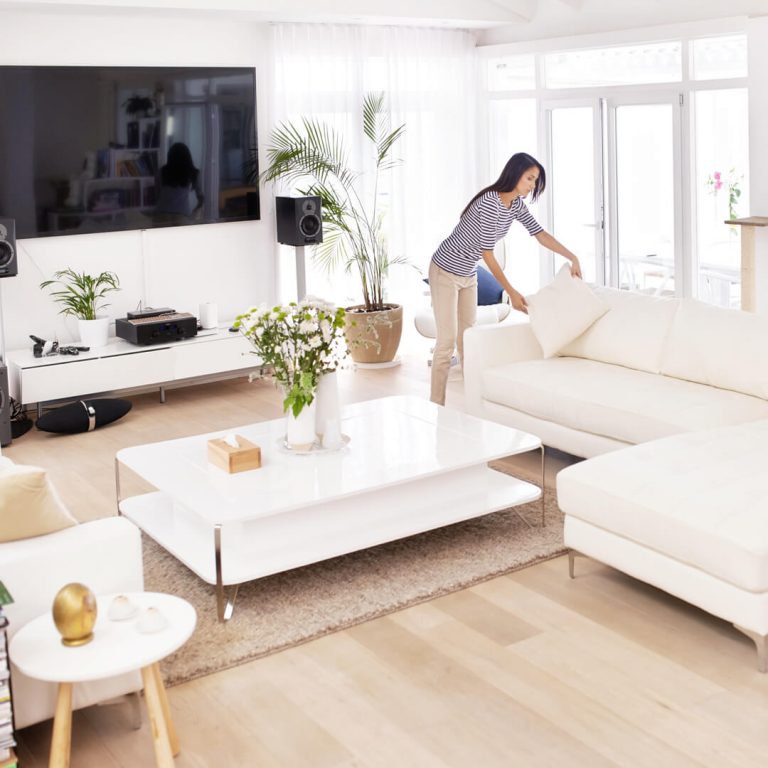Great news for sellers: Millions of people are in the market for single-family homes, townhouses and condominiums. According to the National Board of Realtors, 5.64 million existing homes were sold in 2020. With so many so many homes changing hands, how do you make yours stand out to buyers? What will it take for shoppers to know that your house is the one for them?
Read on for tips to make your home attractive to buyers (and appraisers).
Home improvement starts outside.
Not too long ago, prospective home buyers piled into their real estate agent’s sedan to tour homes selected by the agent. Today, the buyers are in the driver’s seat, with 76% of all buyers finding their home on a mobile device, and letting their agent know which homes they’d like to see. The decision is largely based on the pictures featured in the listing.
That’s why sprucing up the outside of your home is a great first step to capture the attention of prospective buyers: first impressions matter.
Take a walk around your property with your real estate agent or a friend to get a fresh eye about the pros—and especially the cons—of your house’s exterior.
Not sure where to start? Seeding your lawn is a project that will give you one of the highest returns on investment: expect to recoup over 300%. Here are some additional curb appeal basics to look for:
- Is the house dirty? Consider hiring a professional to power wash the house, walkways and driveway, or renting a pressure washer to do it yourself.
- Are the shrubs and trees overgrown? Are the weeds under control? Is the lawn neatly mowed and edged? While many curb appeal fixes will need to be done just once, the lawn and weeds will need constant attention from the time you put your home on the market until the day the sale closes.
- Is the trim around the front door or garage door peeling? A quart of paint will do the trick.
- Has the paint on the front door faded? If it has, repaint it—and consider changing the color. Homes with black front doors can sell for $6,500 more than expected.
Don’t forget the finishing touches; many are inexpensive additions that will attract home buyers.
- Plant flowers or put potted flowers around the front door.
- Add a fresh doormat.
- Replace or paint your light fixtures and be sure all the bulbs work.
- Polish your house numbers or replace them.
- Change the mailbox if it’s outdated or shows signs of rust or other wear and tear.
- Conceal the garbage cans in your garage or a fenced-in area.
…and then moves inside.
Once your home’s exterior is in tip-top shape, it’s time to apply the same process to the interior.
If you have lived in your current home for some time, the interior may be where you and your family have lived and made memories. The pencil marks on the wall measuring your children’s growth are precious to you—but could be construed as dirt to someone else. The nail holes in the mantel where you hang the Christmas stockings are a tradition—but holes to a prospective buyer. A home that’s clean, welcoming and refreshingly free of clutter can make a world of difference, with one realtor stating that easy cosmetic updates priced at $12,000 to $15,000 made a “house instantly worth $40,000 more.”
Ask a friend to walk through the house to make a list of things you must depersonalize before you sell. A neutral party can look through the eyes of a home buyer to see what you’ll need to remove.
Take down the family pictures from the walls and the tops of the dressers and pack them up safely for your next home. Remove things that are precious to you—family heirlooms and antiques—that might make your home look dated. Homebuyers want to envision their family photos and their belongings in a fresh, modern space, not be reminded that another family occupies the home.
Next begin decluttering. You might love your sectional, even though it leaves little walking space in the living room. Move it into temporary storage while you try to sell your home. Big furniture gives the impression that rooms are small. If you have a favorite chair that is faded or stained—but you’re keeping it—send it to storage. Dirty furniture will give buyers the idea that your house is dirty, too.
If you’re selling your home in the winter, pack up your spring and summer wardrobe and move those clothes and shoes into storage. Home buyers will think your closets are graciously sized when the clothing is limited. You also can pack up your books, or donate some to charity, as well as the pots, pans and dishes you can live without until you get to your new home.
Not only will your home be more appealing to buyers, you’ll have a head start on packing for the move.
…followed by sprucing pp.
For most of us, a lived-in house looks just that way: lived in. Spots on the carpet, a ring in the bathtub and scratches in the paint are signs of everyday life.
But they aren’t the signs buyers want to see. Prospective buyers who are about to drop nearly $363,700—the average price of a home in the U.S.—will expect to buy a residence that’s clean from top to bottom.
Here’s a checklist of items to clean, either yourself or by hiring a crew:
- Windows, inside and out, including the sills and tracks
- Appliances, both the interior and exterior
- Countertops, including grout
- Bathroom fixtures, including tubs, toilets and sinks
- Plumbing fixtures, such as shower heads, which often have a mineral buildup
- Cabinets, inside and out
- Carpet
- Hardwood floors
- Blinds and other window coverings
- They should be dusted and wiped clear of fingerprints and other spots. If you decide to repaint, choose a light, popular neutral color, such as gray or “greige,” a gray/beige blend.
There’s an extensive “to do” list when it comes to selling your house. But when that buyer falls in love with it and offers you a competitive price, the work will have been worth it.







Comments Section
Please note: Comments are not monitored for member servicing inquiries and will not be published. If you have a question or comment about a Quorum product or account, please visit quorumfcu.org to submit a query with our Member Service Team. Thank you.